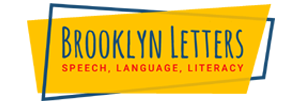PUBLIC SPEAKING

PUBLIC SPEAKING

As Featured In:
Our Speech Language Pathologists Travel To Your NYC Metro Area Home! Expert Private Pay In-Person & Remote Public Speaking Speech Therapy | Free Consultations and Meet & Greets with Our Staff .
Our Speech Language Pathologists Travel To Your NYC Metro Area Home! Expert Private Pay In-Person & Remote Public Speaking Speech Therapy | Free Consultations and Meet & Greets with Our Staff .
FOR SPEECH LANGUAGE THERAPY SERVICES OUTSIDE OF BROOKLYN
We travel to:
BROOKLYN NEIGHBORHOODS
Our Speech-Language Pathologists and Therapists
We travel to you and we also offer remote services. Some of our speech-language pathologists are trained in the Orton Gillingham approach. Many of our speech-language pathologists are trained in literacy and offer support with decoding, spelling and reading fluency services. Our speech-language pathologists and therapists work with babies, toddlers, school-age students, and adults with expertise in:
Our Speech-Language Pathologists and Therapists
We travel to you and we also offer remote services. Some of our speech-language pathologists are trained in the Orton Gillingham approach. Many of our speech-language pathologists are trained in literacy and offer support with decoding,
spelling and reading fluency services. Our speech-language pathologists and therapists work with babies, toddlers, school-age students, and adults with expertise in:
What is Public Speaking?
Consider an occasion when you were requested to speak in front of a big group. This can be anything from giving a presentation at work, moderating a work meeting or conference, or delivering a speech at a family gathering. Is that encounter bringing up any unpleasant emotions? Many individuals connect public speaking with a terrible experience that we would want to avoid at all costs. However, public speaking is sometimes inevitable. You don’t have to be nervous whether you’re a kid making a class presentation or an adult speaking at your best friend’s wedding.
What Makes Public Speaking Challenging?
Some of the most common reasons that make public speaking a challenge for many individuals include:
- Little experience with public speaking.
- Viewing public speaking as a show rather than as a means of connecting with an audience
- Speech preparation and development are limited
- The anxiety of the speaker
- Inexperience with using technology relating to the speech (video clips, Powerpoint presentations, music, etc)
What Does "Connection" Imply?
Making a connection with your audience is the most important aspect of public speaking. Sure, you have something to say, and it’s no doubt interesting. However, if you focus on your material rather than the audience with whom you are sharing it, you will miss out on the connection.
Connecting with your audience does not imply feigning empathy or being unduly vulnerable. It’s about demonstrating that you’re not simply talking for the sake of talking, but that you’re engaging in a human discussion with other individuals.

How Do You Connect with Your Audience?
1. Greet your audience. It may seem strange to have to say this, but what’s even stranger is how many individuals fail to do so. When you rush into a presentation, whether on stage or through video conference, without pausing to address your audience, you are not treating them as individuals. Begin with a “Hi!” or “Hey, how are you?” Thank them for attending or for inviting you to speak in front of them. Recognize the event and the cause for your presence. Discuss what you’re going to talk about and why you believe it’s essential to them.
2. Plan your conversation around their interests, not yours. Assume you’re a business owner presenting a new product to a group of investors. Do you think you should start by establishing your credentials? By recounting the lengthy, arduous path that leads to your idea? No. The investors are there to earn money, so go right to the point and talk about the urgent problem you’re solving and the massive market that awaits you. Tell them where they fit in and why you want to work with them specifically rather than anybody else. It’s essentially the same pitch you’d deliver to another group, except this time it’s geared to the individuals in the room.
3. Tell tales that are meaningful to your audience. Using real-life examples may help to make your speech more memorable, captivating, and engaging. But be picky about which stories you tell. If you’re touring the world to raise money to treat kids’ diseases, don’t keep recounting the same heartbreaking tale of a family friend’s daughter who died too early. Choose stories that are as near to home as possible. Find stories of local children to help you explain your topic more sympathetically.
4. Avoid doing anything that draws attention to your differences from the audience. People can lose interest in your words, thoughts, and information in a matter of seconds. Convert your data to centimeters and liters if your audience utilizes the metric system so they don’t have to do it themselves. Avoid using scientific words when speaking to a fourth-grade class. If you’re presenting information to a Brazilian audience, mention research they can trust, preferably one that’s in Brazil and easy to look up. When presenting data, making sure you have a reliable and reputable source is always necessary. But your message will gain more impact when you present information in a localized language and context that your audience can easily understand.
5. Don’t merely consider the information. People still bother with meetings and presentations in an age where most information is instantaneously available online for one reason: they require social context—someone they trust—before they can absorb knowledge. Your Zoom quarterly sales report updates are more than simply you reeling off data figures. People notice your appearance, bearing, manner, and how well you deliver information. So talk, dress appropriately, keep your hands visible, relax your shoulders, straighten your back, smile (particularly if you see someone you know), and create eye contact.
6. Tell stories, use humor, and use effective language. Incorporate a humorous tale into your presentation, and you will undoubtedly capture the interest of your audience. A personal touch in a speech is often appreciated by audiences. That is something that a narrative can deliver. Even Aristotle, a renowned public speaker, felt that listeners are more interested in who we are and how we convey information than in the subject itself.
7. Remember to pause. Pauses may be a very effective strategy in public speaking since they help both the speaker and the listener. Research shows that the average professional speaks at a rate of 150 words per minute. By utilizing pauses, you allow yourself some time to quickly gather your thoughts and observe your audience. It also gives the room time to process the message you just delivered and ponder on the implications of your information. Properly timed pauses also raise the impact of your message.
8. Use inflection to stress important points and captivate your audience. Inflection, also known as voice modulation, is defined as a “shift in the pitch or tone of the voice.” It is classified into four types: upward, downward, level, and circumflex. Varying your tone during the speech—gently raising your voice to signal an inquiry, slightly dropping it to complete a declarative phrase, speaking louder to suggest joy or quieter to express grief—can help you in keeping your audience awake and maintaining their attention.
9. Amplify your message using gestures and movements. During presentations, people pay attention to motions and gestures. If you use your body to emphasize a point, such as applauding or pointing, the audience is far more likely to remember what you say. This public speaking approach is used by powerful presenters throughout their speeches and it certainly works.
10. Use eye contact. A careful glance in the eyes of an audience member might convey how much you value their opinions. When you make eye contact with your audience, it creates a more personal atmosphere. It makes your listeners feel as though they are having a conversation with you as opposed to just listening to a discussion or a presentation. It forges a link between the speaker and the listener, a bond that benefits both sides. When you look someone in the eyes, they are more inclined to look at you, listen to you, and believe in your message.
11. Have a well-organized and structured speech. The audience can tell when a speaker has given enough time and effort to prepare a speech or if they are simply “winging it.” Having a well-organized speech means you are less likely to go around in circles or deliver an ambiguous message. When you are clear and concise, it will be easier for your audience to digest the information, ask relevant questions, and reach the conclusion you wish for them to make. In turn, you’ll be able to answer their questions and clarify your points more effectively. Begin with the body while planning a speech. Based on your study and accompanying resources, determine the major topics of a speech. The major points should support the thesis statement and aid in the achievement of the general and particular goals. Topical, chronological, geographical, problem-solution, cause-effect, and Monroe’s Motivated Sequence are several organizing patterns that can assist in organizing the major ideas of a speech.
A speech-language pathologist is an expert in the field of communication. Brooklyn Letters’ speech language pathologists have the highest level of training to help you achieve your public speaking goals. Let us identify the best techniques to help you overcome your concerns and become a confident speaker.
MEET OUR BROOKLYN SPEECH LANGUAGE PATHOLOGIST WHO TRAVEL TO YOUR HOME

Alina G.
M.S. CCC-SLP/TSSLD, SPEECH-LANGUAGE PATHOLOGIST

Briana I.
M.A., CCC-SLP, TSSLD

Dr. Michelle M.
PHD CCC-SLP, TSHH, SPEECH LANGUAGE PATHOLOGIST

Liza B.
M.S., CCC-SLP, TSSLD, SPEECH LANGUAGE PATHOLOGIST

Stacey R.
M.S., CCC-SLP, TSSLD, SPEECH LANGUAGE PATHOLOGIST

Rachel
M.S., CCC-SLP, TSSLD, QOM

Christina A.
M.S., CCC-SLP, SPEECH LANGUAGE PATHOLOGIST
FREE CONSULTATION!!!
Call: (347) 394-3485,
Text: (917) 426-8880
Email: [email protected]
(we respond to email right away!)











